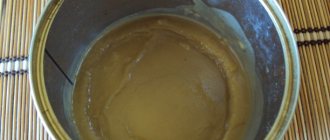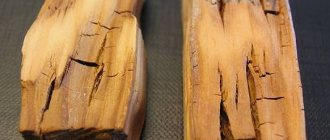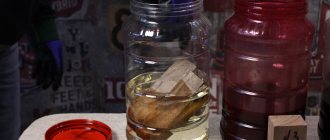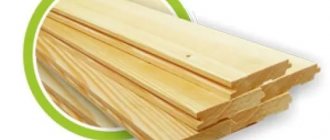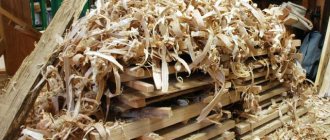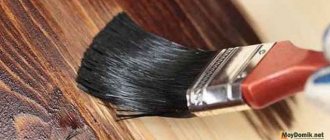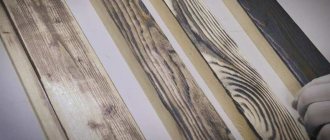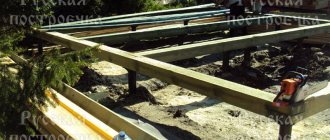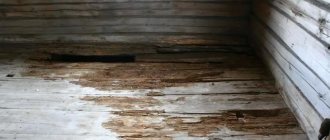When treating wood with paint or varnish, you cannot be sure that the material is completely protected from pests and rot. Surface treatment of products with waterproof agents protects against external moisture entering the wood texture. But, since the tree contains tree sap, the product is subject to rotting processes over time. Treating wood with copper sulfate prevents any decay processes without changing the shade of the wood. An important advantage of the composition is its harmlessness to humans and animals.
Why coat wood with copper sulfate?
Treating timber with copper sulfate is the best way to improve performance, from freshly cut wood to finished buildings. The texture of wood fiber is very similar to a kitchen sponge. Wood absorbs moisture not only in direct contact with water, but also from the air at high humidity levels.
If the lumber is dried incorrectly or insufficiently, the remaining tree sap leads to rotting of the entire structure. Treating wood against rotting with vitriol is an effective antiseptic. Copper sulfate is a blue powder that does not have a distinct odor. The sulfuric acid salt is moderately toxic to animals and humans, but bacteria and many insects living in the body of wood die from their high toxicity.
Copper sulfate is characterized by the following parameters:
- has an astringent effect;
- has antiseptic properties;
- disinfects the treated area.
When processing raw materials or a finished product with a solution, the fungi, bacteria and insects already present in it are killed, and further infection by woodworms, mold microbes and various kinds of fungi is also prevented. The use of copper sulfate solution in everyday life is possible due to its non-volatility, non-flammability and relative harmlessness.
What is important to know?
Copper sulfate, in addition to its availability, has other positive characteristics.
This product is not flammable or volatile. Once absorbed, the substance will not cause harm to humans, but it is necessary to work with it with gloves.
Another feature of copper sulfate is that it can corrode metals.
Therefore, when processing wood, you need to make sure that there are no nails, clamps or any other metal objects in it.
This information must also be taken into account when diluting the solution; accordingly, the bucket should not be made of iron.
So, wood preservation occurs with the help of a solution of copper sulfate; it can also be used to treat diseased trees.
How this is done, in what ways - about everything in more detail.
Types of wood treatment with vitriol
In practice, copper sulfate (copper sulfate) is used in different ways to treat trees. Each wood processing method has its own characteristics.
Surface application of sulfate to wood
The method is the easiest, does not take much time, but the period of wood protection is minimal. Surface application of copper sulfate to a product or trees in the garden is done when there are already existing problems of rot or any bacteria. When applying copper sulfate to fresh and poorly dried wood, there is a possibility of rapid leaching of the substance from the wood fiber.
Wood processing procedure:
- In order to prepare a solution of copper sulfate, it is necessary to sift the substance through a fine sieve and dilute it in water in a ratio of 1:100;
- Moisten a brush or foam sponge in the diluted solution;
- Apply a solution of copper sulfate to the wood;
- When treating the garden or large structures, you can use a sprayer.
Treatment of wood by soaking in solution
This processing method is often used for wooden posts that will be dug into the ground (for example, a fence). In large-scale construction, the technique will take a lot of time and money. But development companies that maintain their image, despite many inconveniences, prefer this method.
Soaking wood begins with preparing a 20% solution into which the wood material is immersed. Soaking takes 2 days, and drying takes about a month, since the treated wood dries naturally, folded under a canopy.
Internal impregnation of wood
This technique is used on a newly cut tree. The tree sap has not yet left the trunk, and the sap flow will continue for several more days. As the sap moves through the wood, copper sulfate mixes with it and penetrates into the deepest layers of the tree.
Wood impregnation process:
- The processed wood is laid on the ground;
- A chainsaw makes a transverse cut (almost in half);
- A wedge is inserted into the resulting gap to increase the distance between the sawn parts of the tree;
- A lead pipe is inserted into the crevice, with the other end leading into a solution of copper sulfate;
- The gap must be sealed with resin or plugged with tow to preserve the solution in the wood;
- The simple device is left to soak for three days, and then the material is thoroughly dried.
Features of tree structure
The location of the fibers in wood helps the material to absorb quite well a large amount of moisture coming from the outside. In this way it is somewhat reminiscent of the properties of a sponge.
- In addition, the trunks, when they have just been cut down, necessarily contain remaining vital juices.
- While performing useful functions during the growth and development of a tree, after cutting, they, on the contrary, contribute to the deterioration of the properties of tree species, accelerating the process of their decay from the inside.
If the outside of a wooden product can be protected by applying varnish or painting it, then such a thin surface film can provide protection exclusively for the outside.
But it is not capable of beneficially influencing processes of a biological nature in the internal part of a wooden structure.
A more significant effect can be obtained if you use biocidal-based antiseptic substances for these purposes. Copper sulfate, for example, or as it is also called copper sulfate, is quite often used in these cases in practice.
Industrial processing of wood material
Processing wood with copper sulfate in industry involves the use of professional equipment. The wood goes through a whole series of events, starting with drying the wood, loading the dried material into an autoclave, and soaking itself in a vitriol solution. The substance penetrates into the deepest wood fibers thanks to a maintained temperature of +40 ° C and a constant pressure of 10 atmospheres. Artificially created conditions make it possible to spend only 30 minutes on the soaking process, after which the wood is removed and sent for drying. It is not possible to recreate this technology at home.
What happens if you take the wrong dosage?
The packaging with copper sulfate contains detailed instructions for the preparation and use of the drug. It is enough to follow these recommendations exactly so as not to harm the plantings.
Important: mixing with any other substance other than lime is unacceptable.
How to dilute copper sulfate 1% for treating trees and other plants
Instructions for preparing the solution:
- Fill a glass or plastic container with warm water.
- Pour the required amount of powder (100 g per 10 l).
- Stir it with a plastic spatula until completely dissolved. The concentrate should be diluted carefully and thoroughly so that no lumps or crystals remain. Wooden instruments cannot be used, as this material will absorb the active substance.
- Allow to cool to room temperature and pour into spray tank.
- Now you can treat plants, soil or greenhouse with the substance.
The prepared solution should be used on the same day. After standing for more than 10 hours, it will become useless.
The effect of the drug begins at least 2 hours after contact with the surface, bark or soil. Lasts up to 2 weeks. Rain will reduce the effectiveness, but even with heavy rainfall the procedure cannot be repeated.
Knowing all the rules for properly treating plants with copper sulfate, you can carry out safe preventive care for them. In the future, this will definitely bear fruit in the form of lush flowering and a bountiful harvest.
Copper sulfate is a common remedy in the fight against mold, fungi and wood rot. Its popularity is caused, first of all, by its availability: you can buy it at any hardware store.
In this regard, many are interested in the question - how to properly treat wood with copper sulfate?
Most often, the solution is used in everyday life; it is used to treat trees and leaves in the garden at the dacha.
The main reason for wood rotting lies in its origin.
Wood is a natural material, capable of breathing, releasing juices, thereby increasing its humidity.
Even after treating the wood with paint, varnish or any other coating, it will not be possible to avoid the internal process of rotting. Therefore, very often they resort to treating wood with copper sulfate.
The use of copper sulfate in gardening
Of the wide range of agrochemicals for pest control, copper sulfate is highly effective. The big advantage of the drug is that pathogens do not become addicted to it.
Copper sulfate is a fungicidal and biocidal preparation that has won the trust of most gardeners in the country. The solution is actively used in the treatment of diseases of garden trees, grapes, vegetable crops and ornamental plantings. An effective remedy against powdery mildew, drying out, rot, late blight, scab and black cancer.
Autumn treatment of fruit trees with copper sulfate is carried out after the leaves have completely fallen; in the spring, treatment should be carried out before the buds open. When treating garden trees, copper sulfate should be diluted in a dosage of 10 g of the drug per 1 liter of water. To disinfect the soil, use a 5% solution of the drug. Disinfection can be carried out once every five years, a month before sowing grain or planting seedlings.
Use of the drug in gardening and horticulture:
- Spraying bushes and trees to increase their immunity;
- Spraying to combat harmful insects;
- Spraying to combat fungal diseases of trees;
- Restoration of the garden after fruiting or serious illnesses;
- Spraying to disinfect cut areas on trees and shrubs;
- Spraying vegetable crops to fertilize the soil.
Preparation and instructions for use in various conditions
If you do not follow the rules and dosage when using the substance, you can harm the plant. There is even a high probability of his death.
Responsible gardeners perform autumn spraying in stages:
- urea;
- ferrous sulfate;
- copper sulfate.
The last two types are carried out immediately before cold weather to prepare the plants for wintering.
Treating trees with copper sulfate in the fall: proportions, instructions
The procedure is carried out only after the foliage has completely fallen. Otherwise, the copper will end up in the soil. Oversaturation is fraught with disruption of metabolic processes in all nearby plants. When the growing season begins, this will be manifested by the fall of the ovaries, as well as leaves.
Important: the fungicide is diluted before use, because it can “burn” the garden. If the concentrate gets on the plant, it will leave a wound.
To ensure that the consumption of the active substance during woodworking is optimal, experts calculated the average amounts of liquid:
- young animals under 3 years of age - up to 2 liters;
- at 3-4 years - up to 3 liters;
- 4-6 years - 4 l;
- adult and actively bearing fruit - 6 l.
When applied to the bark, diluted copper sulfate is not harmful to the plant, and unlike iron sulfate, it is practically not washed off by rain.
Younger individuals should be sprayed with a weak substance of 1-1.5%. For adults, 3% (300 g per 10 l) is suitable. When lime is added, Bordeaux mixture is obtained. This increases the effectiveness of the drug. But the use of the product is permissible only in the fall, because it leaves burns on the leaves.
The prepared solution is poured into the container of the apparatus and the crown and trunk are evenly covered with a layer of liquid in the “fine dew” mode.
Trees, like berry gardens, must be prepared in accordance with basic sanitary standards before processing: remove old bark and branches that are diseased, dried out, or growing incorrectly.
Spraying bush plants in the garden
Copper sulfate saves stone and pome crops from most fungal diseases: currants, grapes, gooseberries, etc.
For a medium-sized shrub, 1-1.5 liters of a 3 percent solution is enough. Spray from top to bottom, making sure that the liquid does not flow down the branches in streams - this will be too much, and a large amount of the substance can destroy the plant.
Important: when there is a need to repeat autumn treatment, the preparations should be changed so that copper does not accumulate in the soil.
Soil disinfection
The soil is treated with a weakly saturated solution of copper sulfate once every 3-5 years. Take 5 g per 10 liters of warm water. In this case, the subsequent application of additional fertilizers - compost, humus.
The substance is distributed using a sprayer or watering can over the surface. Fine irrigation significantly increases the effectiveness of copper sulfate.
If after sanitary treatment there are wounds and cuts on the bush, they should be smeared with a disinfectant, and after it has dried, painted over or covered with garden varnish.
Important: substance consumption, regardless of concentration, is 2 l/m².
Application in greenhouse
A disinfectant for disinfecting structures is prepared at a concentration of 1% (100 g of powder per 10 liters of water). It is preferable to use a warm base.
- Clear the greenhouse of any remaining vegetation, ropes, stakes and other foreign objects that may become saturated with the substance. It's better to burn them and use new material next time.
- Inspect the structure for damage. If present, seal with sealant.
- Clean the surface with soapy water to remove dirt.
- Treat metal elements with a 9% vinegar solution. Scratches must be cleaned, primed and painted. To avoid rust.
- Prepare copper sulfate according to the instructions on its packaging or according to your individual recipe.
- Soak all wood elements with the resulting substance. Apply with a paint brush.
- Wash the inside of the coating using a sponge soaked in solution. If there has been a severe infection, additionally spray everything with a spray bottle.
- Wait until it dries completely (at least 5 hours) and repeat the procedure. It is advisable to process up to 5 times.
- Prepare a solution for soil disinfection or Bordeaux mixture. Water the soil with the substance using a watering can with a “rain” attachment.
- All areas with mold should be cleaned with sandpaper or a spatula, and then wiped with copper sulfate. After 5 hours, treat the area with a sponge soaked in the same product.
Precautions when working with the drug
When processing a garden, a plot of land, or simply wood material, protective clothing and additional protective equipment in the form of a respirator, goggles and gloves are required. It is necessary to plan garden treatment on a day without expected rainfall and wind. If the solution gets on the mucous membrane, immediately rinse your mouth, face and hands with plenty of water. Even despite the minor danger that copper sulfate can cause to humans, the solution is still a chemical substance and can cause harm to the human body.
When working with vitriol, it is forbidden to eat or smoke, as the substance can get on the mucous membrane and cause intoxication of the body. The remaining solution should not be poured into storm drains, drains and ponds, and other places where there may be a concentration of people and animals. After completing work, you should thoroughly wash your hands, face and rinse your mouth.
Why is it important to treat the garden in spring?
Preventive spraying of garden trees and shrubs must be carried out annually.
Often, the activity of pests and diseases at an early stage, when it is still easy to cope with them, is invisible. And in an advanced state, many ailments are difficult to treat.
The main garden treatment is scheduled for spring or autumn. During these periods, there are no leaves on perennials that can be burned by a pesticide, so you can use the most powerful products and solutions of strong concentration.
After autumn treatment, some pests may survive and spread throughout the garden in the summer, when the use of fungicides can damage the crop.
In early spring, insects and fungi are weakened by unfavorable conditions, and at this time they are easy to destroy.
Important rules to follow
Despite the fact that the drug is safe for crops, it must be used with caution.
Due to errors in the use or preparation of the working fluid, plants can be significantly damaged.
To avoid this, follow these rules:
| Feature of the product | Rules of application |
| Spoils in unsuitable containers | Copper sulfate solution should not be prepared or kept in metal containers. Glass, plastic, and wooden dishes are suitable; you can use enameled metal containers. The lime solution for a mixture with copper sulfate also cannot be diluted in an iron bucket. |
| Dissolution depends on temperature | Crystals do not dissolve well in cold water. In order not to wait for cooling, first pour a portion of the powder with a small volume of hot water, and then dilute it with cold water. |
| Incompatible with many pesticides | The drug must not be mixed with insecticides based on organophosphorus compounds and other substances that decompose in an alkaline environment. When adding solid soap to a solution, copper precipitates and the product loses its strength, so use only liquid soap. |
| Can be mixed with sulfur | For joint treatment against diseases and mites, as well as to enhance the antifungal effect, you can use a mixture of copper sulfate and colloidal sulfur, as well as sulfur-based preparations (such as Tiovit Jet). |
| Short shelf life | It is recommended to use the finished solution within 5-6 hours. The maximum permissible storage period is 10 hours. |
| Demanding weather conditions | To get the most out of spraying with copper sulfate, choose a day for work that is forecast to be followed by at least 3 days of dry weather. Otherwise, rain will wash away the protective film before it has an effect on most pathogens. |
| Danger to plants in hot weather | Do not use the drug in sunny and hot weather (air temperature above +30°C). Otherwise, burns may appear on the leaves and bark of young branches. |
| Affects the soil | Treatment of tree trunk circles should be kept to a minimum, since copper accumulates in the soil. In addition, as an acid salt, copper sulfate can increase the acidity of the soil, but not radically. |
Processing steps and phases
To prevent fungal and bacterial diseases, one treatment with copper sulfate is usually sufficient. But it is rare to find a garden that does not have a single disease, so spraying is worth repeating.
When fungi appear, it is permissible to make up to 4 treatments in the spring. In addition, rain washes the fungicide solution from the branches, so to contain infections it is necessary to renew the protective layer.
Pests are activated by waves; the best time to combat them depends on the type of insect.
But the capabilities of copper sulfate as an insecticide are limited; it is effective only against certain sucking and gnawing pests, such as aphids. It is better to use other drugs.
Before the buds swell
As warming begins, colonies of fungi begin to develop. During this period, it is important to treat pears and apple trees with copper sulfate, otherwise scab will appear; spray cherries, cherries, plums and peaches to protect against anthractosis, moniliosis, powdery mildew and coccomycosis.
Pests emerge from hibernation later, but treatment of shrubs against bud moths and aphids should be carried out already at this stage. Currants suffer the most from these insects. In this case, you can use copper sulfate.
The concentration of the eradicating agent depends on the degree of damage that was observed in the previous season and on the timing of spraying. If the plants are dormant, you can use a 3% solution.
The day before the leaves bloom
The first pests appear, damaging the swollen buds and buds (weevil, flower beetle), so insecticides are mainly used for treatment.
Copper sulfate at this stage is used for spraying berry crops.
If the buds have burst, but the leaves have not opened, the concentration of the solution should not exceed 1.5%.
Flower buds turn pink
The garden is attacked by many pests, such as leaf rollers, mites, aphids, codling moths, sawflies, and weevils. Both fruit trees and berry bushes should be sprayed.
During this period, it may be necessary to combat spotting, coccomycosis, monilial burn and scab, against which copper sulfate helps well.
To treat the crown during the period of bud formation, it is better to use a 0.5-1% solution.
Formation of ovaries
The best time to combat leaf curl, as well as the second wave of moniliosis and codling moth. The processing required at this stage is the same as during the budding period.
Features of processing various crops
Each type of fruit and berry plant reacts in its own way to treatment with copper sulfate. The range of diseases that a culture can suffer from also differs.
Based on these features, prevention and treatment are also carried out differently.
| Culture | Processing Features |
| Quince | Spraying with copper sulfate is used only in spring. The procedure is performed before flowering begins. Dissolve 100 g of powder in 10 liters of water and process, using 2-5 liters of liquid for each tree. |
| Apple and pear | In spring, up to 3 applications of these crops are allowed, while the consumption of the product is gradually reduced. The first spraying is carried out before the leaves bloom with a 3% solution. Not only the crown and trunk are irrigated, but also the soil in the circle around the trunk. This will require 3-4 liters of working fluid per plant. After 2 weeks, the treatment must be repeated to consolidate the result. This time, prepare a 1% solution and spend 2-5 liters per tree. The third spraying is done as necessary at the stage of ovary formation. The concentration of the working fluid is reduced to 0.5-1%. One copy consumes 2.5-5 liters. |
| Peach and apricot | Spraying with copper sulfate is carried out once in the spring. It is necessary to have time before flowering begins. For processing, 1% working fluid is used, consumption per tree is 2-3 liters. |
| Cherry, sweet cherry, plum | These crops are processed in spring and autumn. In the first case, dissolve 300 g of powder in 10 liters of water. To irrigate the plant, use 2-3 liters of this product. |
| Raspberries, gooseberries, currants | Shrubs are sprayed with copper sulfate once a year - in the spring, before the leaves bloom. Apply a 1% solution, spending 1.2-2 liters per bush. |
| Grape | Prevention involves spraying in spring and autumn. At the beginning of the growing season, treatment is carried out with a 3% solution, excluding the oldest plants with coarsened bark - in this case it is worth increasing the concentration to 5%. The consumption rate of working fluid is 1.2-2 liters per plant. Carry out the procedure no later than the first flowers bloom. |
| Wicker and bush rose | Before unfurling the leaves, spray the rose plantation with 1-3% product at the rate of 1 liter per hundred square meters of planting. On the eve of flowering, you can re-treat using 500 ml of a 1% solution per plant. |


